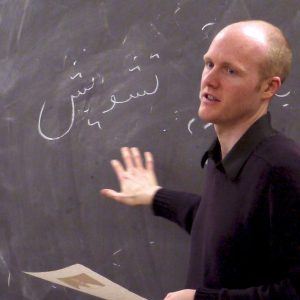The first two years of the HUF experience are centered on the core Hindi-Urdu language courses taken each semester. The courses teach Hindi and Urdu concurrently. The first-year curriculum includes a thorough training in both the Hindi (Devanagari) and Urdu scripts, since few recruits know both scripts (and some know neither). HUF Director, Rupert Snell, supervises the Hindi component of all core language courses while HUF Associate Director, Syed Akbar Hyder, directs the Urdu component. All core languages courses are taught by HUF’s distinguished faculty. Below are sample course descriptions from core language courses:
First-Year Core
The purpose of the first-year HUF program is to bring all students to a good level of proficiency in reading, writing, understanding, and speaking Hindi and Urdu, using both scripts. HUF recognizes that different students will have very different starting points on this journey; the course has been designed in a flexible way to accommodate these differences. Students should not be concerned if you find that others in the class are more advanced in some aspects of the work, be it knowledge of a script, fluency in speaking, or comprehension; the Flagship team works hard to ensure that each student has the support and instruction appropriate to his or her individual needs, and that each student makes the maximum progress possible.
During this course, the basic grammar of Hindi-Urdu is thoroughly reviewed, and detailed instruction in both writing systems is given. Teaching materials include published grammars and course books, specially created video materials, film clips and film songs, and items taken from the media.
Second-Year Core
The second-year core class develops students’ ability to understand and discuss contemporary social issues, both conversationally and in writing. We focus primarily (but not exclusively) on particular themes emerging from contemporary events in the subcontinent. Our readings include selections from reports from the media, documentation about the problems faced by India’s vernacular languages in a globalized world, and passages from fiction and poetry. We look in detail at the registers and styles used in these various contexts: what kind of Hindi do writers and broadcasters use, what are the characteristics, advantages and limitations of these styles, how much do they differ from colloquial Hindi, how are global concerns expressed in (or translated into) Hindi—and what can we learn from all this?
We utilize this material in a number of different ways. We analyse language use; respond to, summarize or critique individual articles; frame questionnaires on relevant social issues and solicit responses from Hindi speakers on campus, writing these up as survey reports; and discuss the fullest possible ranges of topics in class. Class discussion, written homework, recorded interviews and individual presentations ensure that all students engage fully with a wide range of important material that is closely relevant to the experience of living and working in a Hindi or Urdu speaking environment.


